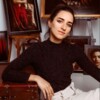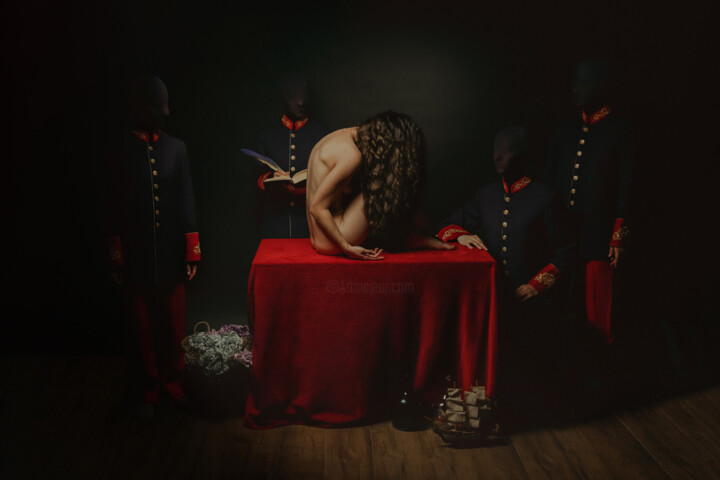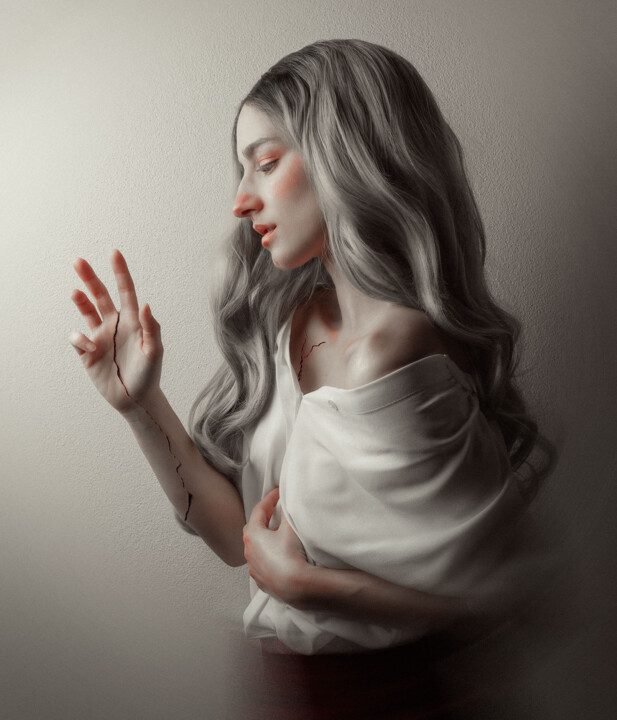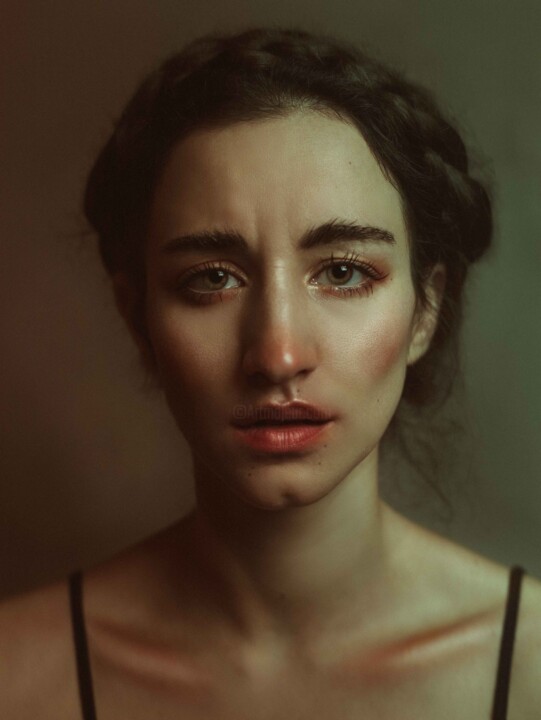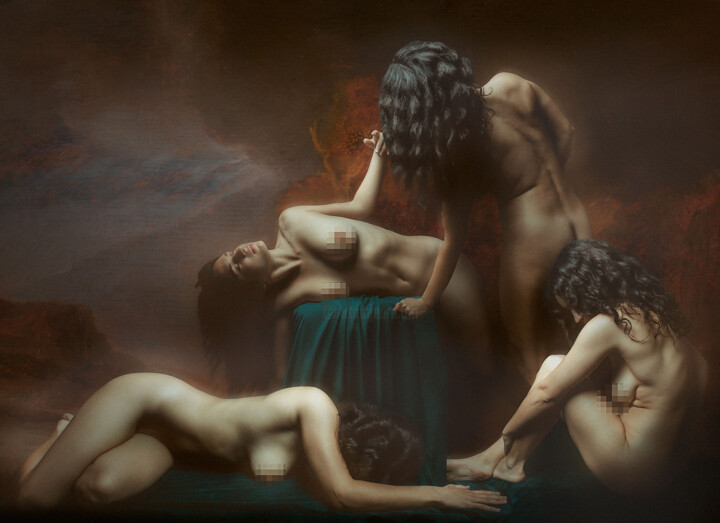What inspired you to create art and become an artist? (events, feelings, experiences...)
When I started experimenting with self-portraiture, I did it purely for introspection. I saw it as a way to look at myself from the outside to understand myself from the inside, and on some occasions, I would even dare to say it served as therapy. Little by little, I began sharing these images and using them to share my personal experiences. I realized that many people found them helpful for reflecting and processing their own emotions, and it was at that moment that I understood my work had a purpose in society. Today, I see my art as, on one hand, an essential tool to talk about my concerns, my learnings, and my experiences, and on the other hand, as a way to understand where we come from and where we are going. I love creating connections between past and present narratives and thinking about how we will be viewed in 1000 years. I want that when future generations study us, they will know we were also a civilization with a great sensitivity for art and that technology also had a pacifying and beauty-creating purpose.
What is your artistic background, the techniques and themes you’ve experimented with so far?
When I was just 16, I went to study photography in Málaga. I started studying analog photography, spending a whole year focused on taking and developing photographs with film. During this time, I understood photography from its roots, from its foundation. I discovered such a wonderful technique that I decided to continue studying it, and as soon as I finished, I pursued a higher degree that was much more focused on digital imaging. During these three years, I experimented with all kinds of cameras and formats, from a shoebox with light-sensitive paper to large-format cameras. At 19, I had the opportunity to do my internship in Rome, where I spent three months with the Parioli Fotografia team, a very active studio organizing courses and exhibitions in the city. During this experience, I discovered my passion for art and began experimenting with self-portraiture. Over the years, I have tried all types of photographic genres, but I haven’t found one that moves me as much as staged photography.
What are the 3 aspects that differentiate you from other artists, making your work unique?
I don’t think I do anything technically unique or different from other artists. Anyone can learn to light a scene or edit with Photoshop and achieve spectacular effects. For me, what makes each artist different is the emotional load carried by each of their works. The story behind it, all the emotions involved in the creative process—the anger, the frustration, or even sadness, fascination, or happiness. The experience of each individual and their soul are things that cannot be replicated, and that’s what makes each artist’s work unique.
Where does your inspiration come from?
I tend to be very curious and pay attention to everything happening around me. Inspiration can come to me through family stories, during my study moments, museum visits, or even in a conversation with friends. When I find a topic that catches my attention, I tend to become quite obsessed and look for a lot of information about it. I read articles, search for related images or paintings, and look for historical events to compare with how we see things now. During this process, many of the ideas that later appear in my final work come up.
What is your artistic approach? What visions, sensations, or feelings do you want to evoke in the viewer?
At first glance, I want the viewer to feel uneasy. I fill my works with an aura of mystery and a dark atmosphere that makes the viewer want more, want to know what lies behind all that darkness. It's in the second impression when the connection with the work happens, when the viewer searches for similar experiences and similarities with their personal reality. For some, it may just remain an aesthetic and beautiful work, while for others, it might open up a whole mountain of emotions. This is the wonderful part of bringing works out of the studio—to see how they appear differently to the eyes of each individual in society.
What is your creation process like? Spontaneous or with a long preparatory process (technical, inspiration from art classics, or others)?
I always say that my creative process starts with a sketch, but in reality, it starts with research. As I mentioned earlier, during the research phase, I find many of the elements I want to appear in the work, and I write them down to later make the sketch with a lighting scheme and the set design. With this plan, I start looking for all the props I need—backgrounds, floors, costumes, and all objects that support the message I want to convey. Once I have the set ready, I do the first lighting test and leave everything prepared for the session. During the session, I take the photos planned in the sketch but also allow myself space to experiment and follow my intuition. Sometimes, with the scene in front of me, I prefer to change the position of some objects or even the pose of the characters. Once I have all the necessary photographs, I begin the post-production. This is the part where I let myself go the most; I would even say that sometimes I enter a sort of trance. In the end, the movement of my hands as I retouch the photographs with a pictorial style is not much different from the act of painting or drawing, and I guess that takes me back to my childhood and evokes very positive feelings. The final step is printing the work— for me, the process is not complete until I have the physical work in front of me.
Do you use any particular work technique? If so, can you explain it?
One of the techniques present throughout my work is the pictorial effect. I create this effect both with makeup and later in post-production. In makeup, I use shadows and highlights to emphasize the light points on faces and bodies, creating a sense of three-dimensionality right from the start, which I later enhance with Photoshop. Through Dodge & Burn and frequency separation, I hide what I don’t want and highlight what I do. The use of shadows and light helps me create a texture reminiscent of classical painting, as well as adding more drama and emphasis to the lights and shadows in the image.
Do you have a format or medium you feel most comfortable with? If so, why?
Working digitally gives me absolute freedom in creating. I feel that I have fewer limits, and the ability to go back and make changes during the process stimulates my creativity and encourages me to experiment and keep learning.
Where do you create your works? At home, in a shared studio, or in your own workshop? And in this space, how do you organize your creative work?
I’ve created works in spaces as small as a 3x3 meter room, using the door to hang the background, and as large as the rooms in a 13th-century castle in northern Italy. It’s funny because the work created in the smallest space (Censored Art - 160x110cm) ended up being the largest one I have in my studio today.
In recent years, I’ve traveled and moved several times, so space has never been a limitation for me. That’s what I love about digital art – it allows you to create entire universes with just a computer and a graphic tablet.
I currently live between Spain and Italy, so I have a small studio in my hometown in Spain, and when I’m in Italy, I usually create at home or in the Castle of Monesiglio when it’s available.
Does your work take you traveling to meet new collectors, for fairs or exhibitions? If so, what does it bring you?
Having the opportunity to travel with my work is very rewarding. Exhibiting in cities outside of Spain, such as Rome or Rivoli, has given me new perspectives on the art world. I believe that each culture and country has its own "filters" when it comes to valuing art, and for me, it is very interesting to see how the viewer’s opinion changes from one country to another.
Staying in your own home country means closing off the borders to an audience who might fall in love with your work at first sight.
How do you imagine the evolution of your work and your career as an artist in the future?
I imagine more complex works in terms of the setting and characters. In the future, I want it to be necessary to come back two or three times to see the work and still find details that were not noticed before. I want the format of the photographs to be so large that it gives the viewer the feeling of being inside the scene.
Additionally, I aspire to continue working on my presence in the international art market, traveling, participating in both collective and solo exhibitions, art fairs, and collaborating with galleries and collectors.
What is the theme, style, or technique of your latest artistic production?
My latest work is "The Judgment," a 60x90cm staged photograph on Hahnemühle baryta paper, which speaks about self-judgment, how humans are capable of limiting themselves out of fear of external judgment, but in reality, it is self-criticism that paralyzes them.
It is a neo-baroque style piece that creates a sense of unease due to the constant observation of the faceless figures surrounding the central character.
The image is a self-portrait created with digital photomontage, consisting of up to 6 images taken in the same setting and under the same lighting conditions, which were later merged in Photoshop to create a room full of people.
Can you tell us about your most important exhibition experience?
Last summer, I had "Oscura Luce," my first solo exhibition in Italy, at the Museo Casa del Conte Verde in Rivoli, a 15th-century building located in the historic center of the city. The exhibition marked my entry into the international market, generating significant media attention in Italy.
If you could have created a famous work in the history of art, which one would you choose? And why?
The Calling of Saint Matthew by Caravaggio, which is in the Church of San Luigi dei Francesi. I believe this piece has two elements that are incredibly inspiring for me: the number of people frozen in a precise moment within the scene, and the great use of chiaroscuro by Michelangelo Merisi. I think it’s a work where you can get lost in looking at all the details and trying to understand what each character was feeling at the moment of the event. I like that in the scene, there is a separation between the characters and the viewer, as if they are unaware that we are watching them.
If you could invite a famous artist (living or dead) to dinner, who would it be? How would you suggest they spend the evening?
I have many artists I would love to sit down with and ask numerous questions to learn from them, but since I can only choose one here, I would go with Eugenio Recuenco, a Spanish photographer and artist who works with both cinematic and pictorial photography. I would ask him to explain his experience throughout his career working with creative photography in Spain.




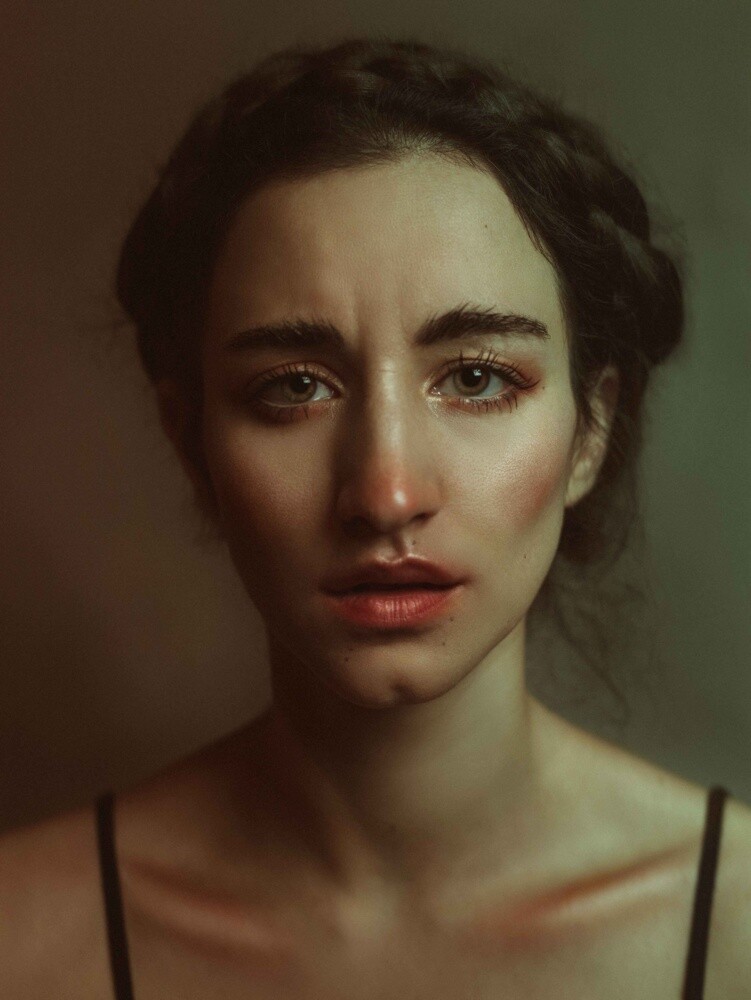

 Olimpia Gaia Martinelli
Olimpia Gaia Martinelli
